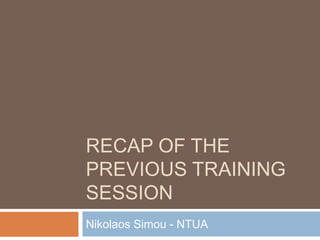Recap of the previous training session
- 1. RECAP OF THE PREVIOUS TRAINING SESSION Nikolaos Simou - NTUA
- 2. Outline ’é© Basic Concepts ’éż EDM ’éż EDM Sounds Profile ’é© MINT instance for Europeana Sounds ’é© Topics to be discussed in the 2nd Training
- 3. Basic Concepts - EDM ’é© Europeana Data Model ’éż The Europeana Data Model (EDM) is aimed at being an integration medium for collecting, connecting and enriching the descriptions provided by Europeana content providers. ’éż EDM is an ontology. In other words it can be considered as a vocabulary consisting of classes and properties that describe the Digitized Cultural Heritage domain 3
- 4. EDM Classes and Properties ’é© Classes ’éż edm:ProvidedCHO ’éż edm:WebResource ’éż edm:Agent ’éż edm:Place ’éż edm:Timespan ’éż skos:Concept ’éż ore:Aggregation ’éż edm:Collection ’é© Properties ’éż dc:title or dc:description ’éż dc:language for text objects ’éż dc:subject or dc:type or dc:coverage or dcterms:spatial ’éż edm:type ’éż edm:dataProvider ’éż edm:isShownAt ’éż edm:isShownBy ’éż edm:object ’éż edm:provider ’éż edm:rights 4 EDM full documentation at http://pro.europeana.eu/page/edm- documentation
- 5. Basic Concepts ŌĆō EDM Sounds ’é© EDM Sounds Profile ’éż An extension of the EDM ontology for better fitting the content provided by the Europeana Sounds Project 5 ’é© Classes ’éż mo:MusicGroup ’é© Properties ’éż mo:remaster_of ’éż mo:track_number ’éż ebucore:hasGenre ’éż ebucore:dateDigitise d ’éż ŌĆ”EDM Sounds full documentation at http://pro.europeana.eu/taskforce/edm-profile-for-sound
- 6. What is MINT? ’é© MINT is an open source, web based platform for Metadata INTeroperability ’éż It has been successfully used in more than 15 Europeana feeder projects ’éż More than 6.000.000 metadata records have been produced by it and published on Europeana 6
- 7. MINT for Europeana Sounds ’é© Available at ’éż http://mint-projects.image.ntua.gr/sounds/ ’é© MINT is used within the project for ’éż The transformation of providers in house metadata to high quality EDM Sounds and EDM metadata. ’éż The publication of EDM metadata on Europeana.
- 8. MINT Workflow ’é© Create a user and an organization ’é© Import your metadata ’é© Perform a mapping to EDM Sounds ’é© Check the validity of your mapping ’é© Transform your metadata ’é© Preview, check the quality and publish ’é© Check the numbers on NTUAŌĆÖs OAI-PMH server
- 9. Create a user and an organization ’é© http://mint-projects.image.ntua.gr/sounds/ ’é© Click on ŌĆ£I want to registerŌĆØ 9
- 10. User Registration ’é© Fill in the form and click on ŌĆ£SubmitŌĆØ 10
- 11. Create new organization ’é© Administration ’ā© Create new organisation 11
- 12. User roles 12 ’é© Administrator: This user can create/update/delete users and children organizations for the organization he is administering. ’é© Annotator & Publisher: This user has all the rights of an annotator as well as rights to perform final publishing of data. ’é© Annotator: This user can upload data for his/her organization (and any children organizations) and perform all available data handling functions (view items, delete items, mappings etc) provided by the system, apart from final publishing of data. ’é© Data Viewer: This user only has viewing rights for his organization ’é© No role: A user that has registered for an organization but has not yet been assigned any rights.
- 13. Import your metadata 13 ’é© Formats ’éż CSV ’ü« UTF-8 Encoding ’éż XML file containing metadata for one or many records ’éż ZIP/TGZ file containing many XML files ŌĆōone per cultural heritage object ’é© Protocols ’éż HTTP upload ’éż Open Archives Initiative - Protocol for Metadata Harvesting (OAI-PMH) ’é© Import Recommendations ’éż TGZ files containing no more than 50.000 XML files
- 14. Import your metadata 14 ’é© My workspace ’ā© Import new archive
- 15. 15 Define Items
- 16. Create new mapping 16 ’é© My workspace ’ā© Dataset Name ’ā©Mappings ’ā©New Mapping
- 18. Input Schema Area 18 ’é© The tree represents the snapshot of the XML schema that is used as input for the mapping process. The user is able to navigate and access element statistics and also to search the tree by using the text field on the top.
- 19. Navigation Area 19 ’é© Shortcuts to the EDM classes
- 20. Navigation Area (Cont.) 20 ’é© Bookmarks ’éż A user can set/unset a bookmark to an element by clicking on the star ( ) on its right
- 21. Navigation Area (Cont.) 21 ’é© Mandatory elements that are not mapped
- 22. Navigation Area (Cont.) 22 ’é© Search the target schema
- 23. Mappings 23 Mapping Xpath Constant Concatenate Value Functional Conditional Structural Thesaurus
- 26. Transform Items 26 ’é© Dataset Options ’ā©Transform ’ā© Mapping
- 27. Preview Transformed Items 27 ’é© The transformation icon appears next to the dataset and the derived dataset appears under the transformation
- 28. Prepare for publish 28 ’é© A crosswalk creates the EDM dataset from the EDM Sounds transformation.
- 29. Publish 29 ’é© The publication icon appears next to the dataset and both dataset (EDM Sounds and EDM) are sent to NTUAŌĆÖs OAI-PMH server
- 30. MINT Workflow Harvestin g Mapping MIN T OA I Europea na 30 Transformati on Publicatio n Statistics Import Mapping XSL Output Europeana A ’ā© B ’ā©ŌĆ” NoSQL
- 31. Topics to be discussed ’é© Mappings using EDM Collection ’é© Advanced mapping functionalities ’éż Functional mapping ’éż Conditional mapping ’éż Value mapping ’éż Structural mapping ’éż Structural on any element ’éż Thesauri mapping ’é© Updating published datasets on Europeana ’é© Monitoring of metadata production
- 32. Contact 32 Nikolaos Simou National Technical University of Athens Email: nsimou@image.ntua.gr LinkedIn: http://www.linkedin.com/pub/nikolaos- simou/68/31a/9aa
































